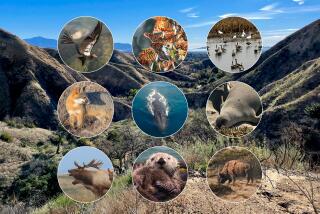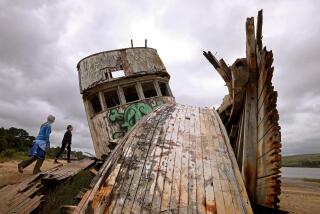A Kayaking Adventure Leads to Tranquillity
ESPIRITU SANTO ISLAND, Mexico — Morning: We lie on the beach in our sleeping bags, listening to the mixed chorus of canyon wrens and gulls.
The bay is a pale sheet of satin. We deserve this--for two days we have paddled in blustery winds, our kayaks slapping the waves, our arms aching.
The change in weather is fortuitous. Today we are headed for the offshore rocks known as Los Islotes, where the sea lions play and the brown-footed boobies nest and the snorkeling is legendary.
After breakfast we pushed off in our fleet of seven kayaks and skimmed across the tranquil bay, our white blades flashing in the sun. Below in the clear waters we could see a colony of garden eels swaying in the current. At our approach they quickly withdrew into the bottom sands.
We slipped around the point and turned north. The breeze was gentle at our backs, the only sounds the rhythmic dip and drip of the paddles.
A Splendid Week
Our small group of city dwellers was enjoying a splendid week of kayaking and camping in the Sea of Cortez. We ranged in age from early 20s to early 70s, and none of us had ever been in a kayak.
Baja Expeditions of San Diego, which organized the trip, provided kayaks, instruction, five guides (three Americans, two Mexicans) and very good food. We were accompanied by a motorized skiff that carried our camping gear and was available in case of emergency.
The boats used are sturdy two-man kayaks, longer and more stable than one-man river kayaks. Foot-controlled rudders help with the steering. We also took turns trying two single kayaks.
Our group flew from Los Angeles to La Paz, capital of Baja California Sur. From there we set off in the skiff for the five-mile run to Espiritu Santo Island, where the kayaks waited.
Before paddling to our first camp we received some basic instructions in technique and safety. Everyone was required to go through a practice wet exit--quickly getting out of an overturned kayak.
We also learned to right the kayak, empty out the water and climb back in. That wasn’t easy, but everyone managed to do it.
From a distance Espiritu Santo appears stony and mean, a forbidding ridge of desert that rises like a dinosaur’s back out of the sea. But up close it is full of stark beauty and rich with life. Morning glories bloom in the shadowy canyons, rainbow-colored fishes dart among the offshore reefs, myriad birds wheel and cry in the skies.
The island’s curious jet-black jack rabbits hop down to drink in rare springs, and feral goats scramble among the rocks. After midnight an occasional ringtail cat will creep into a camp kitchen, scouting for chicken bones.
Espiritu Santo’s western, leeward shore is a convolution of desert arroyos that slope down to turquoise coves and beaches of dazzling white sand. Its eastern coast is a wall of cliffs that drop into emerald swells.
Just north is a smaller island, Partida; the two are connected by a sandy isthmus sliced through by a thin tidal channel. Together, the two islands are about a dozen miles long.
No Permanent Settlements
There is no permanent human settlement here, just a few leavings of the vagabundos , those transient fishermen of the gulf.
For a week we paddled around this remarkable pair of desert islands, putting into a different beach each night. When we weren’t in the kayaks--a few hours each day--we swam, snorkeled, gathered shells, watched birds, hiked up the rugged canyons or just lazed around on the beaches.
At the end of the day we’d draw the kayaks high onto the shore, tie them together and weight them with rocks in case the wind rose during the night. Then we’d haul out a bag of sweet little Mexican limes, mix a quantity of margaritas and settle down to watch the pelicans diving in the sunset.
Meanwhile, the guides would be preparing a superb camp dinner over smoldering mesquite. We feasted on such fare as ceviche, garlic shrimp, marinated octopus, broiled snapper, steak and chicken.
The skiff’s icebox kept vegetables and fruit fresh (and beer cold) for the whole week.
After dinner we would talk a while around the campfire, then crawl into our sleeping bags and track the shooting stars down the desert night.
Exciting Sport
We were also learning something of an exciting new sport--ocean kayaking.
Riding there at the interface of water and sky, propelled by your own paddle, fellow traveler to dolphin and gull, you are subject to wind and tide. And there can be no better place for it than the warm southern Sea of Cortez.
After a day or two we fell into the steady rhythm of pushing and lifting the paddles, working our legs for balance and leverage. We grew accustomed to the whims of weather. Sometimes we slid across glassy bays; sometimes the kayaks rose and fell in scary swells; sometimes we struggled against stiff winds.
Once we rafted five of the kayaks together and, rigging a giant tarp for a sail, made a speedy crossing of a large and windy bay in our makeshift “pentamaran.”
In the whole week not one of the kayaks capsized and we never put our wet-exit training to use.
And the wildlife! Ospreys tended their nests on high ledges, great blue herons stood along the lagoons. At dusk, thousands of frigate birds circled overhead. Traveling low to the water, we were often surprised by a squadron of flying fishes across the bows, or a giant ray flapping its wings in the salt spray.
Once we saw a line of dolphins in the distance, and paddled out to join them. For a while they seemed far ahead of us, then we were among them, a huge pod of maybe 500, leaping all around us, tails slapping the waves, some with hitchhiking remoras attached to their white bellies.
We could hear their high-pitched squeaks, smell their fishy breath. And then they were gone beyond the waves, like a passing storm, leaving us to drift in sudden solitude.
Best of all was Los Islotes, where we spent two mornings snorkeling along undersea cliffs, into caves and through dark-blue canyons. It was like swimming through a guidebook to tropical fishes.
We saw rainbow wrasses, Cortez damselfish, cornetfish, barracuda, angelfish, zebra morays, parrotfish, butterflyfish and others. Every square inch of the rocks was encrusted with marine life--sea fans, neon nudibranchs, urchins, sunstars, crown of thorns.
A Sea Lion Ballet
The entire herd of resident sea lions joined us in the water, swirling around us in a strange ballet, peering into our face masks. We even took a volleyball into the water, and tried to interest them in an interspecies game. Although they wouldn’t play, they did hang around and cheer us on with furious barking.
Often, in the cool mornings, we’d explore the classic desert landscape beyond the beaches. We scrambled over boulders, scattering lizards, and walked through stands of agave and giant cardon cactus.
We saw a few black jack rabbits, specific to this island, with fur black and glossy as obsidian. Cardinals and finches sang among the elephant trees.
Midweek, at a bay called Candelero, we marched up the canyon with buckets, soap and shampoo and enjoyed showers at a freshwater well in an oasis of wild fig trees.
On our last day at sea we rode the tides through the channel between Partida and Espiritu Santo, and paddled beneath the pink and black cliffs on the island’s windward coast. In several hours we came to Bonanza Beach, a two-mile strand of dunes at the southern end of the island. We made our last camp, watched our last wilderness sunset.
The next afternoon we checked into a La Paz tourist hotel. Hot showers. Clean sheets. An evening of mariachis and enchiladas.
Next day, our northbound jet passed over Espiritu Santo and we had our last view of its opalescent lagoons and white beaches.
We had new muscles in our sunburned arms, sand in our pockets, cactus spines in our fingertips. And our eyes were focused on far distances.
Baja Expeditions operates weeklong kayaking trips from November through May. They go to the Sea of Cortez off La Paz in November and December, and from mid-March through May. From January through mid-March the trips go to Magdalena Bay on the Pacific Coast, an area of sand-dune islands, colder waters and mangrove estuarios; it is also a wintering and calving place for gray whales.
The cost of these trips is $650 including kayaks, ground transportation, guides, instruction and food. Air fare to La Paz is extra. You need to bring only a sleeping bag, ground pad and personal gear.
These are learning trips and no kayaking experience is necessary. However, you should enjoy rugged outdoor activity and wilderness camping. You should also be in good physical condition.
Contact Baja Expeditions at P.O. Box 3725, San Diego, Calif. 92103; phone (619) 297-0506.
Suggested reading: John Steinbeck’s classic work on the region, “Log from the Sea of Cortez.”
More to Read
Sign up for The Wild
We’ll help you find the best places to hike, bike and run, as well as the perfect silent spots for meditation and yoga.
You may occasionally receive promotional content from the Los Angeles Times.






